Well, it's been quite some time since I updated this blog due to a busy schedule of work, an interstate trip to pick up my latest classic car, a '67 Mercedes 250, which I drove 1300km from country Victoria after two years of dormancy, a bunch of assorted comitments, and a re-entry into the world of theatre after 10 years, as part of the cast of Grease, and also a funeral under the least pleasant of circumstances... whatever spare time I have had has been spent attempting to sleep or playing with cars and old Macs, whilst also casually keeping abreast of the Mac community. Now, throughout he course of doing that last bit, I managed to procure myself a couple of of new OldMacs, which will be the first topic I muse upon in this entry.
In a nutshell, after having in the past 12 months gotten quite active on 68kmla forums once again, and also discovered and joined the ThinkClassic community (check it out if you havent already... some familiar names and a nice atmoshpere, being rather more relaxed than some), I had taken to keeping a watch on the Trading sections of each community. Not expecting a whole lot to be of geopgraphical relevance, given the considerably small percentage of Australian enthusiasts on the forums, imagine my delight at seeing an advertisement on 68k for some items being sold cheaply and given away in the nation's capital, Canberra. More importantly, the nature of the items meant they were of particular interest to me, as one of them in particular was an OldMac I have yearned to own since it was still relevant equipment... a machine that even just LOOKS like a no-holds-barred powerhouse! What is this machine you ask?

The Power Macintosh 9600/200MP is the one we are talking about here. In 1997, this was about the most insane Mac money could buy. The 9600 just about had it all... Whilst it lacked the AV subsystem of the similar 8600 which was marketted abreast of it, it was a behemoth by OldMac standards, and is even impressive to this day in just how much it packed into that awsomely designed imposing hunk of tower. It had 12 RAM slots which, using RAM available since it's original specs were released, give it a total RAM capacity of 1.5Gb. To put that in perspective, this is more than any G3-based Mac that succeeded it, more than the first G4 model, and on par with the Quicksilver G4. It also contained six PCI slots, a pair of additional drive bays which could accomodate various 5.25' or 3.5" removable media drives or hard drives on easily removable sleds. It had two fast SCSI buses, and video was on a TwinTurbo 128 4MB (or 8MB on some models) PCI graphics card that occupied one slot rather than wasting time with the restrictions and wasted space of onboard graphics, and of course, the powerful PowerPC 604e processor at 200MHz, also easily removable for upgrade like the 8xxx and 7xxx series that were produced alongside it by way of it being installed on an inline socketted daughtercard. This was the base 9600/200. Now, I've always specifically wanted the 200MP... why? because the MP stands for "multiprocessor". The 9600/200MP was one of the few old-world Macs produced in standard trim with dual CPU's, having not one but two 604e's at 200MHz each on the daughtercard. Now, it is worth noting that it isnt exactly the multiprocessing capability we know today. Under normal run of the mill operation, you would not notice much in the way of a performance difference, as most programmess simply were not coded to make any use of a second processor. However there are a handful of programmes which WERE coded to utilise the 2nd proccessor to speed up complex rendering tasks such as those performed in certain graphics and multimedia applications. Realistically, it wasnt until OSX that multiprocessing was fully integrated into everyday computing, however for it to be implemented at all in a desktop computer was quite cutting edge. Also, the openness of the machines architecture meant it was wildly upgradeable and served may professionals well for years and years by way of expansion and upgrades. It had room to customise it for whatever task you wanted to use it for, whether it be in a sound studio, a graphic design lab, postproduction of video... You had the expansion room to burn. I'd always wanted this machine right from the earliest days because it was powerful and looked great, and at the time when I first began to get into Macs for the long haul, it was THE ultimate Mac. Obviously, in those days there was no way my parents were spending the horrendous amount of money Apple charged for their high end machines so I just had to sit and dream, and longingy gaze at the ads in the pages of whatever Mac mag I happened to be reading at the time. Well, years went by, and I eventually got a G3 tower when they were still fairly current, and that served me well for years and became the first of 4 PowerMac towers ending with the G5 I type this on... however I never did get that 9600/200MP. Now, another point I should make is the MP was produced only for about 8 months of total 9600 production and was a very expensive machine purchased only by those with a specific purpose for it, As the dual-processor setup was not particularly useful in regards to boosting everyday performance, the model was replaced by the 9600/350 when the 9600 line was speedbumped. This makes the 200MP a fairly rare machine, particularly in AUstralia where vintage Macs scarcely enter the market anymore and when they do, clowns want drug money for them. Whatever the case, I was always certain I would own one.
Well, fast forward back to earlier this year, and as mentioned, a 200MP happened to come up for sale in Canberra on MLA. Being that I used to live in Canberra and am always looking for an excuse to be there for the sake of catching up with friends and reliving my wasted early 20's as a trashy clubber, I immediately planned my trip before I even got a reply back to verify the machine was still available. it was actually being given away in a half-working state, with a very tidy, working and reasonably priced IIvx... another machine Ive always been fond of... and a IIsi with a suspected bad PSU. The only catch was, all three machines had to go together as a lot because the seller was running out of space. Well, I hopped into the Calais at my earliest convenience and headed to Canberra, and after having a little trouble finding my way around the new rabbit-warrens of Gunghalin, I found myself in the apartment of possibly the only other young (well, if my age is to be considered young) Mac collector ive ever met who takes his hobby as seriously as I do. Long story cut short, I ended up there for a good 2 hours or more exchanging anecdote and playing with old Macs. I unexpextedly left with not only the IIvx, 9600 and IIsi, but a Targa2000 AV card still boxed with software and the original supplied antistatic strap, a spare almost new logic board, a Sonnet Crescendo G3/400-1M CPU upgrade, 2 128MB RAM modules and a disc full of software all for the 9600, as well as a copy of Leopard to replace my damaged copy and a few other knicknacks, and not only that, I left
having made not only a valuable contact but it turns out a great friend whom has actually helped me through some very troubling emotional times recently after some very dismal life events.
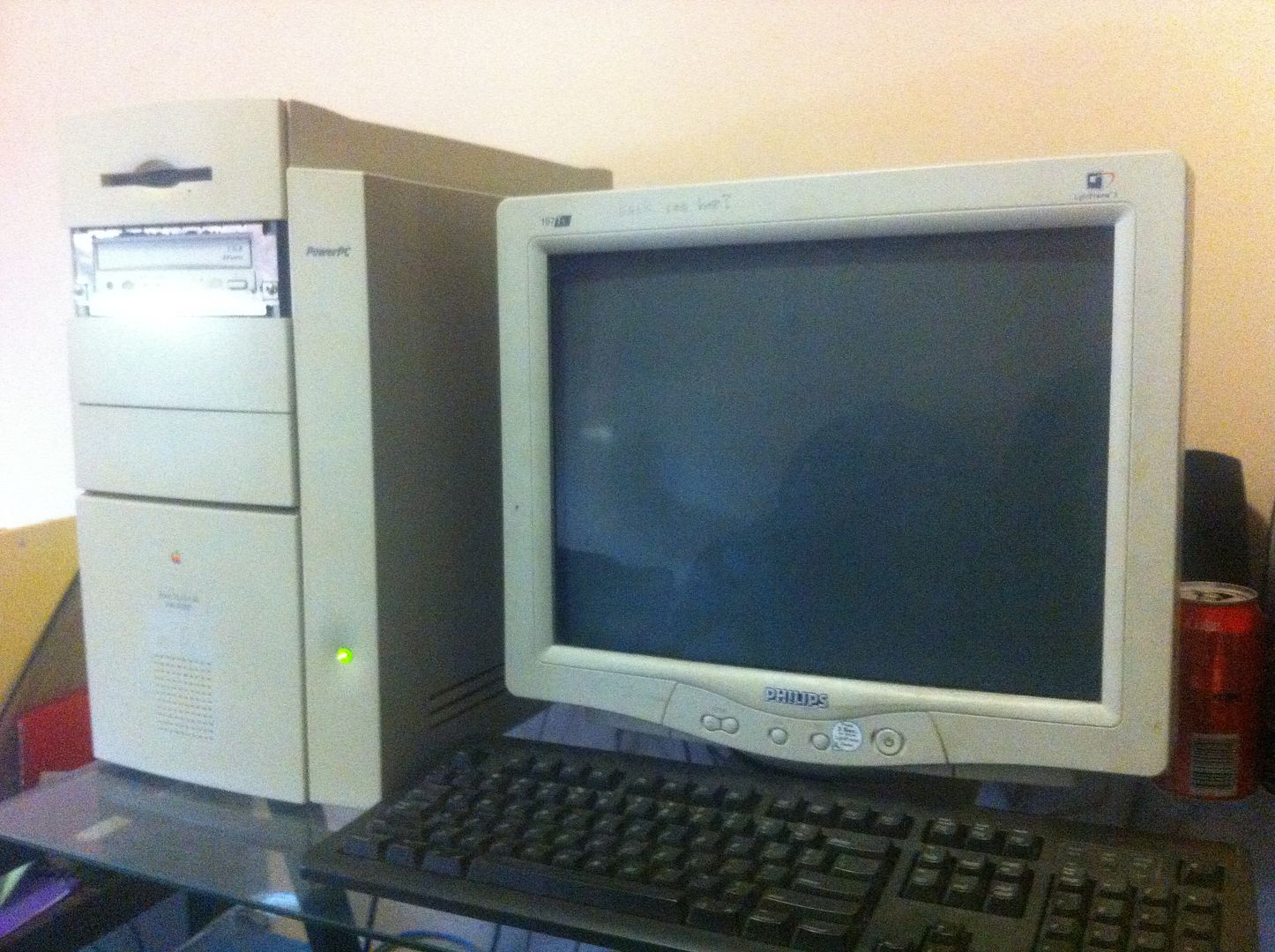

Anyway, I had been told that the 9600 had some flakiness with booting, hence why there was also a spare logic board available. When I got the machine home, I noticed it had an Ultra SCSI card installed, Firewire and USB cards, as well as a 64Mb Radeon7000 Mac Edition graphics card, an 8x CD-Recorder and a pair of sizeable USCSI hard drives in addition to the stock one. After a quick parouse, I turned the machine on and it didnt do much. At best it would switch my VGA CRT on for a second and then off without displaying a picture. Sometimes it would chime, sometimes not... No matter what I did, I couldnt get it to throw a raster. At that point I just assumed the logic board was dead and set about putting the new one in as an easy fix. Too easy, or so I thought... that was until I turned the machine on and it still would not boot. I tried it with both the R7000 and a perfectly functioning rage128 from my G4 but no dice. I tried different RAM configurations, removing selected or all PCI cards... still no luck. I ended up pulling that board and sticking the old one back in which seemed to more consistently chime, then I repeated the whole process. I worked out that seating the graphics card a certain way made it consistently chime... easy fix there. However I still had no display. The machine left me scratching my head for a couple of weeks until... and I have no clue what was going through my head but I'm glad it did... I decided to pull the faulty Rage128 out of my B+W G3 (the G4 and G3 actually have each others cards swapped, with the Rev 2 card being in the G3 and the Rev 1 card being in the G4) which is semi-usable but started displaying terrible artefacts a few years back, and put it into the 9600 to see what happened. Well, to my shock, I got a raster... then a happy Mac when a boot drive was detected on the PCI SCSI card... then a 9.2 open screen through the jailbar like artefacts. It booted to desktop and turned out to already have 256Mb of RAM installed, a whole bunch of good programmes and interesting utilities and seemed to function fine... not just once, but consistently it booted. I even seated the card differently and it still seemed to want to work fine. SUCCESS!!! Well... sort of. I still had no answer to the other cards not working... truth be told, at this point I still have not worked it out. I have been thrown a couple of theories I am yet to test, but I will cover those in another post. It is worth noting at this point that I have since discovered there appears to be either wear or corrosion on the fingers of the "good" Rage card, so it is possible that this explains why it will not function and the other almost identical card will. This does not however explain why it functions in the G4, or why the R7000 will not work.
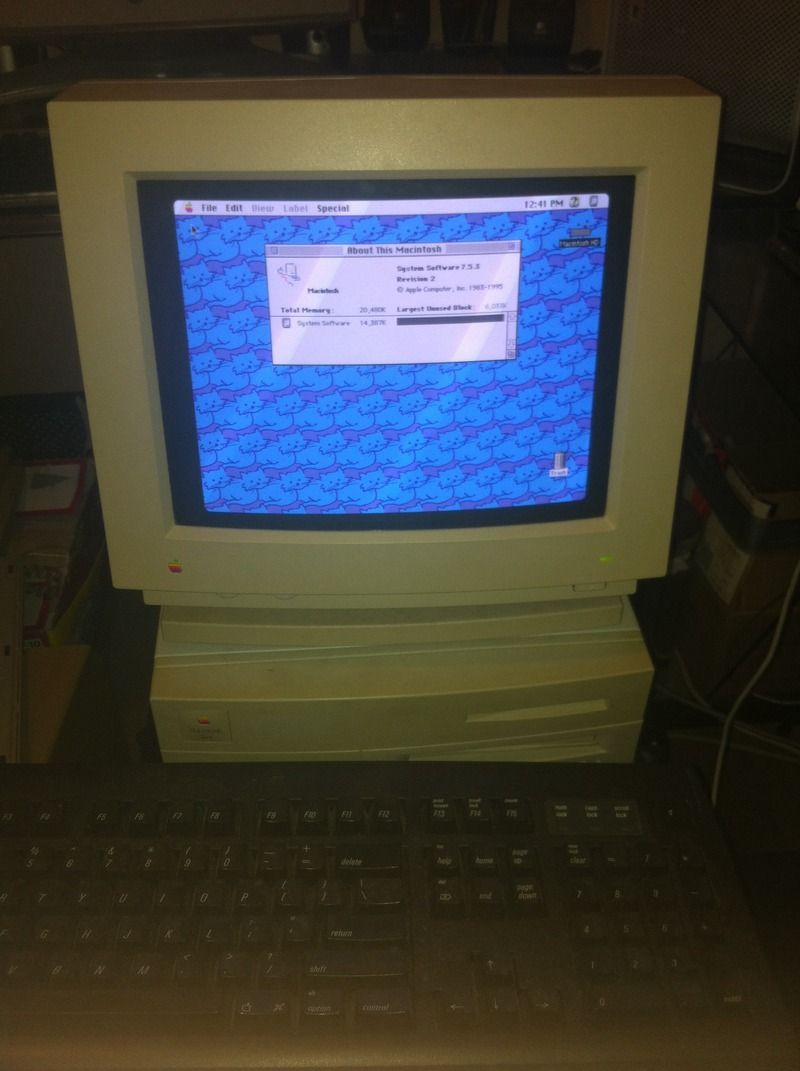 Anyway, having gotten the 9600 at least limping, I loaded in the other 256Mb of RAM and set about playing with the IIvx. Thankfully, it turned out to be absolutely bliss... started right up and booted swiftly into OS7.5.6. Unlike the loaded 9600, this was a very bare bones hard drive... just a basic, simple OS install. It did start to glitch some time later, refusing to power on. This turned out to be due to some new cap leakage causing a short between the legs of an IC or two. I used the old toothbrush trick to rectify the situation temporarily, however this development will mean a recap is on the cards in the near future, along with a mounting pile of other machines. Seeing the potential to be a very useful machine (as my other IIvx is also), I decided that an ethernet card was required for max fun and to explore some ideas that will be covered in a later post here. I made a phonecall to my friend in Canberra and, having seen the teething issues I was having with the 9600, he not only sent in the mail a NuBus ethernet card for the IIvx, but also the original Twinturbo128 full-length PCI graphics card he had acquired for it. When these arrived I began to have quite a bit of fun with the IIvx, and for the first time ever since I bought it, managed to get a perfect display on the 9600 using it's native graphics card. From that moment it has been a fantastic machine and I have found myself using it very regularly even just to browse the web, which it does very competently by way of the Classilla browser for OS9, play music from the shared iTunes libraries of my G5 when I feel like the simplicity of a little mono speaker listening to Hansen, and also it has become a very important bridge machine between OSX and my classic machines, as well as being used as somewhat of a repository for various OS7 bits and bobs, applications, images etc and a useful tool to burn off data CD's to be read by old CD-ROM drives, and a convenient handler of floppies. In adition to all this, It still has a full suite of professional level multimedia software by Adobe and many others including Premiere, Photoshop, Freehand, SonicWORX etc... Given this was designed a a pro-level multimedia-capable machine, I intend to flex it's muscles soon by embarking upon some projects using solely the 9600 to process them.
Anyway, having gotten the 9600 at least limping, I loaded in the other 256Mb of RAM and set about playing with the IIvx. Thankfully, it turned out to be absolutely bliss... started right up and booted swiftly into OS7.5.6. Unlike the loaded 9600, this was a very bare bones hard drive... just a basic, simple OS install. It did start to glitch some time later, refusing to power on. This turned out to be due to some new cap leakage causing a short between the legs of an IC or two. I used the old toothbrush trick to rectify the situation temporarily, however this development will mean a recap is on the cards in the near future, along with a mounting pile of other machines. Seeing the potential to be a very useful machine (as my other IIvx is also), I decided that an ethernet card was required for max fun and to explore some ideas that will be covered in a later post here. I made a phonecall to my friend in Canberra and, having seen the teething issues I was having with the 9600, he not only sent in the mail a NuBus ethernet card for the IIvx, but also the original Twinturbo128 full-length PCI graphics card he had acquired for it. When these arrived I began to have quite a bit of fun with the IIvx, and for the first time ever since I bought it, managed to get a perfect display on the 9600 using it's native graphics card. From that moment it has been a fantastic machine and I have found myself using it very regularly even just to browse the web, which it does very competently by way of the Classilla browser for OS9, play music from the shared iTunes libraries of my G5 when I feel like the simplicity of a little mono speaker listening to Hansen, and also it has become a very important bridge machine between OSX and my classic machines, as well as being used as somewhat of a repository for various OS7 bits and bobs, applications, images etc and a useful tool to burn off data CD's to be read by old CD-ROM drives, and a convenient handler of floppies. In adition to all this, It still has a full suite of professional level multimedia software by Adobe and many others including Premiere, Photoshop, Freehand, SonicWORX etc... Given this was designed a a pro-level multimedia-capable machine, I intend to flex it's muscles soon by embarking upon some projects using solely the 9600 to process them.
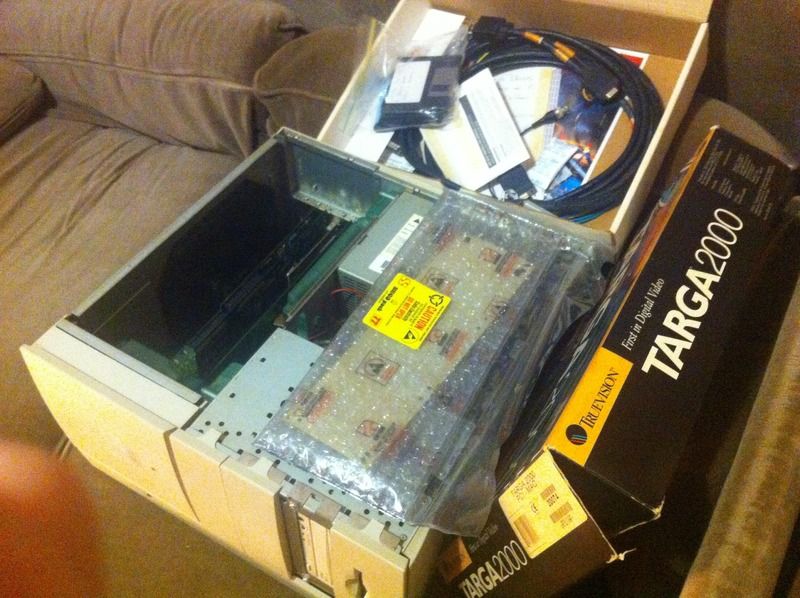
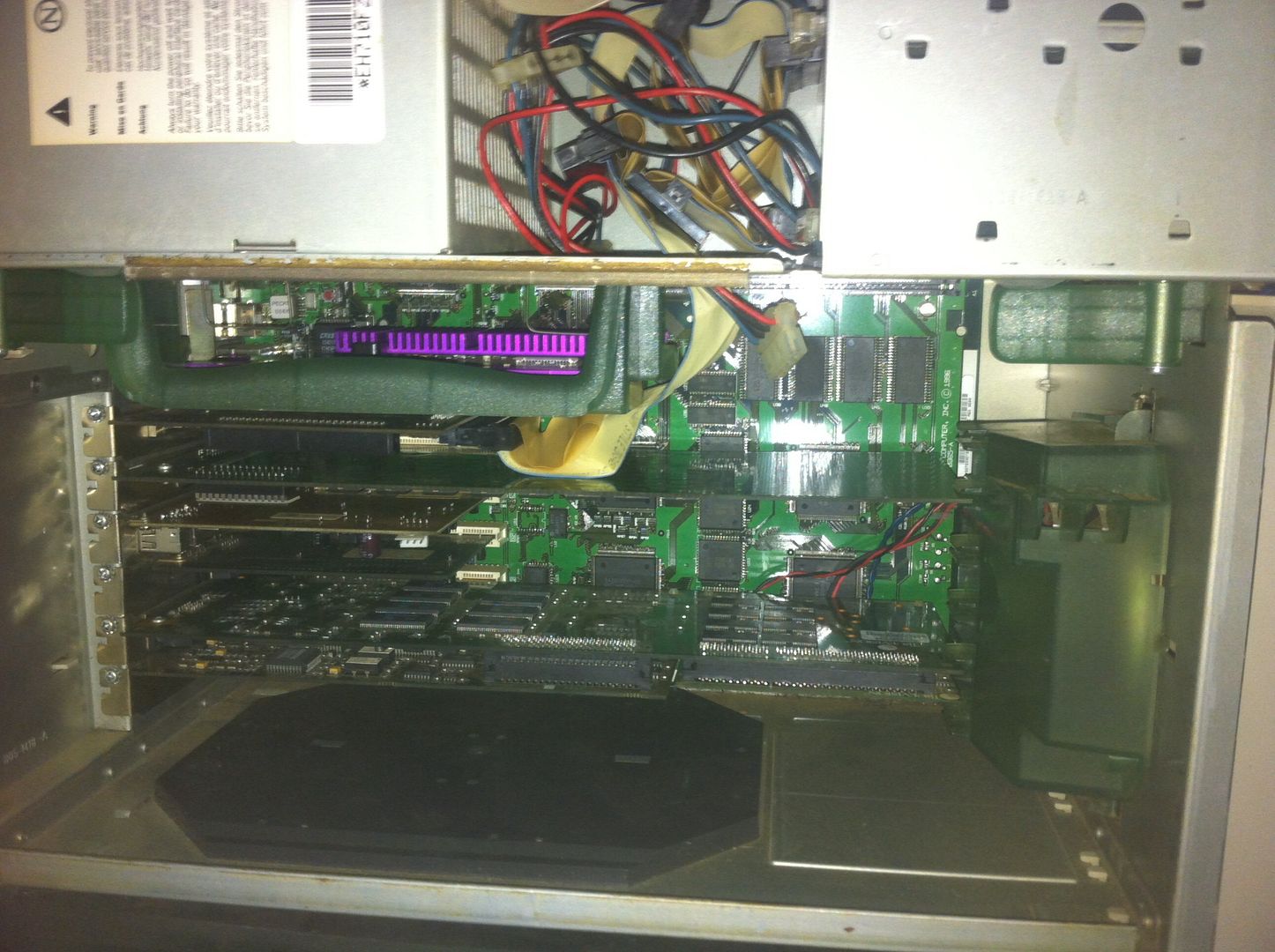 It is worth adding that I have installed the Targa2000 video capture and display output card since getting the video issue sorted out. It is a monstrous piece of equipment, being a full length PCI card with a full length piggyback board that is also populated to half it's length, and has full stereo RCA AV input and output via a breakout harness, as well as the card having a fully functional display controller with VGA output that supports full dual screen or mirrored configuration and a resolution up to 1152x870 @75Hz in millions of colours. These were worth a hefty sum of money when they were new and are still somewhat sought after even now in their relative obsolescence. I intend to procure myself a Hi8 camcorder or something along those lines to have a play round with the capabilities of the machine. I am no stranger to digital video editing the old way with RCA cables and capture hardware/software, however the last experience I had doing so was with a far inferior rig, in the form of a PowerMac 7600/200 with a fairly modest 256Mb of RAM, a pair of 4Gb HDD's and the stock single 604e at 200MHz, a single display and the onboard AV input subsystem. All told, it was a pretty ordinary experience... with the RAM pilfered from that old video rig of mine chucked into the 9600 on top of the 512 it already has, the G3 upgrade, a real capture card and some decent software, it should be a much more enjoyable experience than it was with the old 7600. Anyway.... as you can see from the photo here, it's pretty packed full of goodies inside there. The Targa really is huge. One thing I discovered incidentally, whilst trying to diagnose an apparant conflict caused by the Targa card which caused some really wierd unexpected things to happen was that it MUST specifically be installed in the 2nd slot from the bottom to work correctly. It is apparantly mentioned in the packaging, however the piece of literature that has this instruction is missing from mine. Either that or I am blind. So if you ever end up with one of these cards yourself, this is a thing to keep in mind. It really sent my machine off the rails until I discovered the issue and rectified it!
It is worth adding that I have installed the Targa2000 video capture and display output card since getting the video issue sorted out. It is a monstrous piece of equipment, being a full length PCI card with a full length piggyback board that is also populated to half it's length, and has full stereo RCA AV input and output via a breakout harness, as well as the card having a fully functional display controller with VGA output that supports full dual screen or mirrored configuration and a resolution up to 1152x870 @75Hz in millions of colours. These were worth a hefty sum of money when they were new and are still somewhat sought after even now in their relative obsolescence. I intend to procure myself a Hi8 camcorder or something along those lines to have a play round with the capabilities of the machine. I am no stranger to digital video editing the old way with RCA cables and capture hardware/software, however the last experience I had doing so was with a far inferior rig, in the form of a PowerMac 7600/200 with a fairly modest 256Mb of RAM, a pair of 4Gb HDD's and the stock single 604e at 200MHz, a single display and the onboard AV input subsystem. All told, it was a pretty ordinary experience... with the RAM pilfered from that old video rig of mine chucked into the 9600 on top of the 512 it already has, the G3 upgrade, a real capture card and some decent software, it should be a much more enjoyable experience than it was with the old 7600. Anyway.... as you can see from the photo here, it's pretty packed full of goodies inside there. The Targa really is huge. One thing I discovered incidentally, whilst trying to diagnose an apparant conflict caused by the Targa card which caused some really wierd unexpected things to happen was that it MUST specifically be installed in the 2nd slot from the bottom to work correctly. It is apparantly mentioned in the packaging, however the piece of literature that has this instruction is missing from mine. Either that or I am blind. So if you ever end up with one of these cards yourself, this is a thing to keep in mind. It really sent my machine off the rails until I discovered the issue and rectified it!
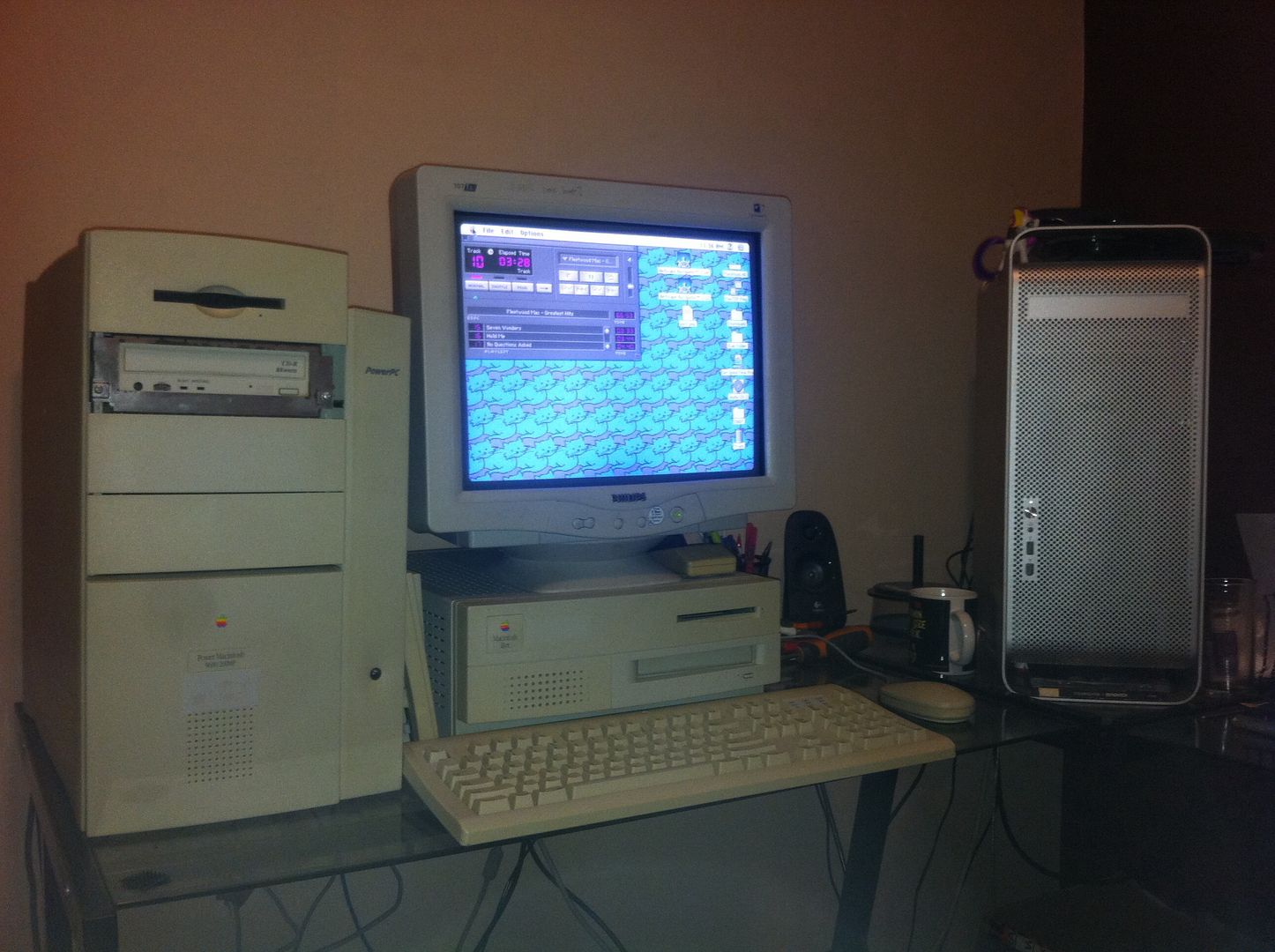
Anyway, now that the IIvx and 9600 are working sterlingly, they are sharing a desk beside the G5 as permanant fixtures. With luck, I should have located a CD bezel and for the 9600 and these possibly could also have a working G3MT as part of that deal to go with my collection of other towers... all depends on some things working out with regards to collecting the gear. Stay tuned for more tales of shenanigans afoot, and until then, I shall leave you with this scene of vintage splendour to the left! OMT











